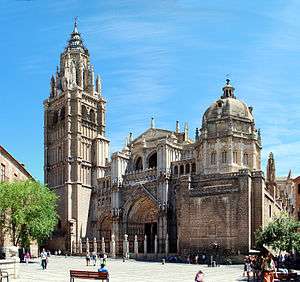Málaga Cathedral
The Cathedral of Málaga is a Roman Catholic church in the city of Málaga in Andalusia in southern Spain. It is in the Renaissance architectural tradition. The cathedral is located within the limits defined by a now missing portion of the medieval Moorish walls, the remains of which surround the nearby Alcazaba and the Castle of Gibralfaro. It was constructed between 1528 and 1782, following the plans drawn by Diego de Siloe; its interior is also in Renaissance style.
| Cathedral of Málaga | |
|---|---|
| Santa Iglesia Catedral Basílica de la Encarnación | |
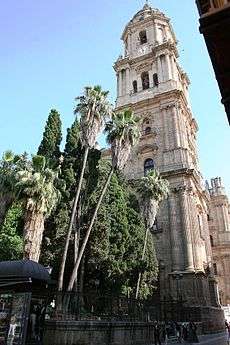 | |

| |
| Location | Málaga |
| Country | Spain |
| Denomination | Roman Catholic |
| Website | malagacatedral.com |
| Architecture | |
| Architectural type | church |
| Groundbreaking | 1528 |
| Completed | 1782 |
| Specifications | |
| Height | 84 metres (276 ft) |
Description
.jpg)
The cathedral, built on a rectangular plan, is composed of a nave and two aisles, the former being wider, though having the same height as the aisles. The choir stalls are the work of Pedro de Mena.
The façade, unlike the rest of the building, is in Baroque style and is divided into two levels; on the lower level are three arches, inside of which are portals separated by marble columns. Above the doors are medallions carved in stone; those of the lateral doors represent the patron saints of Málaga, Saint Cyriacus and Saint Paula, while that over the centre represents the Annunciation.
The north tower is 84 metres (276 ft) high, making this building the second-highest cathedral in Andalusia, after the Giralda of Seville. The south tower remains unfinished. A plaque at the base of the tower states that funds raised by the parish to finish it were used instead to help those British colonies which became the United States to gain their independence from Great Britain. Examinations of the parish registers indicate, however, that the money may have been used instead to renovate the roadway called the "Way of Antequera" (which began in the present street Calle Martinez Maldonado). This unfinished state has led to the cathedral being called "La Manquita", meaning in English, "The One-Armed Lady".[1][2][3]
A series of grand artworks fills the sanctuary, among them are the Gothic altarpiece of the Chapel of Santa Barbara and the 16th century tombs of the Chapel of San Francisco. The Chapel of the Incarnation contains a neoclassic altarpiece (1785) designed by the sculptor Juan de Villanueva and carved by Antonio Ramos and Aldehuela, a group of figures representing the Annunciation and sculptures of the patron saints of Malaga, Saint Ciriaco and Saint Paula, carved by Juan Salazar Palomino also in the 18th century,[4] and The Beheading of Saint Paul, painted by Enrique Simonet in 1887 during his stay in Rome.
Gallery
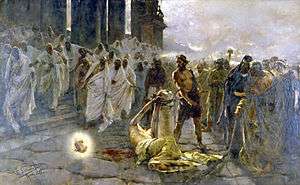 The Beheading of Saint Paul, painted by Enrique Simonet in 1887
The Beheading of Saint Paul, painted by Enrique Simonet in 1887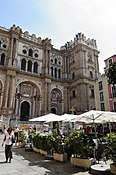

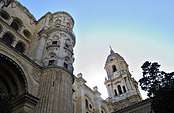
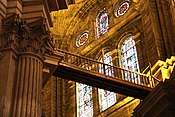
.jpg)
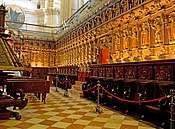
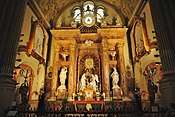
Music in the Cathedral
Notable maestros de capilla of the cathedral include the composers Cristóbal de Morales in his last years (1551-1554), Esteban de Brito (Estêvão de Brito), Francisco Sanz, and (following the sudden death of Manuel Martínez Delgado who died before he could take the position) late baroque composers Juan Francés de Iribarren and Jayme Torrens.
References
- http://www.20minutos.es/noticia/172623/0/catedral/goteras/hay/
- http://www.20minutos.es/noticia/247598/0/obras/catedral/malaga/
- http://www.20minutos.es/noticia/349183/0/rstauracion/cubierta/catedral/
- Teresa Sauret Guerrero (1999). Patrimonio cultural de Málaga y su provincia: Edad Moderna. Arquitectura y urbanismo. Diputación Málaga. ISBN 978-84-7785-374-9.
Sources
- EISMAN, E. L.: "Traducción de una bula de la catedral de Málaga", Jábega, nº 41, Diputación Provincial de Málaga, 1983, pp. 17–21.
- GONZÁLEZ SÁNCHEZ, V.: 'Catálogo general de la documentación del Archivo Histórico de la Iglesia Catedral de Málaga. Málaga: Edinford, 1994.
- RIESCO TERRERO, Á.: "El Archivo Catedral de Málaga: hacia una nueva reorganización y catalogación de fondos", Baetica: Estudios de arte, geografía e historia, nº 9, Universidad de Málaga, 1985, pp. 269–286.
- RIESCO TERRERO, Á.: "Colaboración del Obispo y Cabildo Catedral de Málaga a la empresa real de selección y edición de obras de San Isidoro de Sevilla (Edic. Regia 1597–99) y al enriquecimiento de dos grandes centros documentales: El Archivo General de Simancas y a la Biblioteca de El Escorial", Baetica, nº 11, Universidad de Málaga, 1988, pp. 301–322.
- Esteve Vaquer, Josep-Joaquim; Menzel Sansó, Cristina (2002). "Iconografía musical de los siglos XIV y XV en la catedral de Mallorca". Music in Art: International Journal for Music Iconography. 27 (1–2): 69–79. ISSN 1522-7464.
- SÁNCHEZ MAIRENA, A.: "El Archivo de la Catedral de Málaga: su primera organización a partir del inventario de 1523", E-Spania: Revue électronique d'études hispaniques médiévales, ISSN 1951-6169, nº 4, 2007.
- SÁNCHEZ MAIRENA, A.: "Notas sobre el Archivo de la Catedral de Málaga en el siglo XVI" en M.ª Val González de la Peña (ed.), Estudios en memoria del profesor Dr. Carlos Sáez: Homenaje. Madrid: Universidad de Alcalá de Henares, 2007; pp. 621–650.
- VEGA GARCÍA-FERRER, M.ª J.: "Los cantorales de gregoriano en la catedral de Málaga", F. J. Giménez Rodríguez et alii (coord.), El patrimonio musical de Andalucía y sus relaciones con el contexto ibérico. Granada: Universidad de Granada, 2008; pp. 111–126.
| Wikimedia Commons has media related to cathedral of Málaga. |
